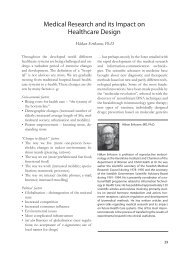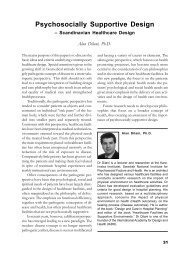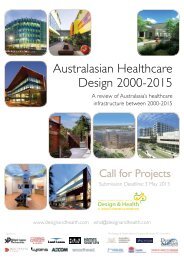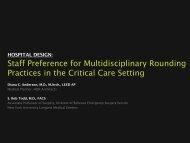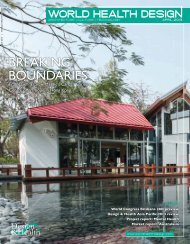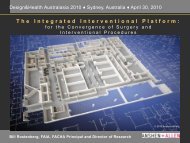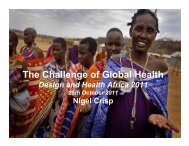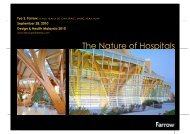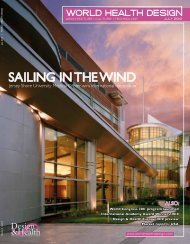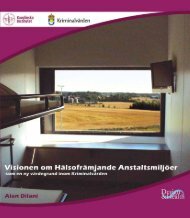SUPER GREEN - the International Academy of Design and Health
SUPER GREEN - the International Academy of Design and Health
SUPER GREEN - the International Academy of Design and Health
- No tags were found...
Create successful ePaper yourself
Turn your PDF publications into a flip-book with our unique Google optimized e-Paper software.
Environmental psychologyIV art IV plants IV seating IV tidinessMean <strong>of</strong> combinedwelcome/comfort ratingMean rating <strong>of</strong> how busydentist wasArt Plants Open Messy 3.73 6.06Art Plants Open Tidy 4.88 4.35Art Plants Closed Messy 3.82 5.99Art Plants Closed Tidy 5.50 4.27Art No Plants Open Messy 4.26 5.81Art No Plants Open Tidy 4.78 4.09Art No Plants Closed Messy 4.10 5.85Art No Plants Closed Tidy 4.41 3.81No Art Plants Open Messy 4.28 5.92No Art Plants Open Tidy 5.97 4.31No Art Plants Closed Messy 3.34 6.33No Art Plants Closed Tidy 5.37 4.08No Art No Plants Open Messy 2.30 6.14No Art No Plants Open Tidy 4.07 3.88No Art No Plants Closed Messy 3.38 6.30No Art No Plants Closed Tidy 3.81 4.21Table 1Overall mean DV ratings (9 = high, 1= low). Highest rated environments are shadeddiscussed, but more to suggest that ‘greenery’is an important element in a wider variety<strong>of</strong> environments than <strong>the</strong> dentist’s waitingroom. However, gender differences mayconfound this fi nding. In a review <strong>of</strong> gendereffects in environmental research, Zelezny,Chua <strong>and</strong> Aldrich 15 found that women heldstronger attitudes to environmental issuesthan men. In <strong>the</strong> Jones study 13 , <strong>the</strong> ratio <strong>of</strong>women to men was seven to three.Study 2: ‘Blues’The relationship between <strong>the</strong> environment<strong>and</strong> physiological aspects <strong>of</strong> wellbeingis important for underst<strong>and</strong>ing <strong>the</strong>health implications <strong>of</strong> different types <strong>of</strong>employment 16,17 . Physical health may beadversely affected by stress 18 , including ‘dailyhassles’ 19 <strong>and</strong> more severe trauma 20 . Studieshave linked wellbeing with windows 7 , , lighting<strong>and</strong> natural illumination 21 , <strong>and</strong> naturalviews 11,22,23 . Mood (affect) has been suggestedas <strong>the</strong> mediating factor linking environment<strong>and</strong> wellbeing, with pleasant environmentsei<strong>the</strong>r evoking a positive affect or lowering<strong>the</strong> negative affect <strong>and</strong> buffering <strong>the</strong> impact<strong>of</strong> stress. Restorative environments havebeen shown to lower blood-pressure 10,24<strong>and</strong> cardiac inter-beat interval 25 .The aim <strong>of</strong> this study was to examine <strong>the</strong>infl uence <strong>of</strong> view on employee mood <strong>and</strong>self-rated health at a single workplace, basedon <strong>the</strong> work <strong>of</strong> Ulrich 8,9,23 <strong>and</strong> Hartig et al. 10.The hypo<strong>the</strong>sis was based on <strong>the</strong> probablelink between <strong>of</strong>fi ce view <strong>and</strong> wellbeing, withmood as a likely mediating factor. A goodview was predicted to be associated withhigher positive affect <strong>and</strong>/or lower negativeaffect scores – <strong>and</strong> with better perceivedhealth. Confounds from age, organisationalseniority <strong>and</strong> sex were anticipated.MethodEighty anonymous participants wererecruited through a questionnaire deliveredto staff mailboxes at <strong>the</strong> National Institute <strong>of</strong>Water <strong>and</strong> Atmospheric Research (NIWA),in Wellington, New Zeal<strong>and</strong>. There were noinducements. The NIWA building is orientedroughly north-south. Offi ces ei<strong>the</strong>r facedeast, with a natural view, or west, facing anurban development. The 200+ employeeswere mainly scientists, <strong>and</strong> formed a relativelyhomogeneous population in work tasks,socio-economic status <strong>and</strong> intelligence.The questionnaire instructed participantsto consider <strong>the</strong>ir responses “while at work”.It included <strong>the</strong> Positive <strong>and</strong> Negative AffectSchedule (PANAS) 26 for mood states, <strong>and</strong>three visual analogue scales (VAS). The fi rstrated job satisfaction, <strong>the</strong> second was forperceived health, <strong>and</strong> <strong>the</strong> third assessedhow <strong>the</strong> participant rated <strong>the</strong> health <strong>of</strong> anaverage person <strong>of</strong> a similar age. Demographicquestions covered <strong>the</strong> employment variablesat <strong>the</strong> NIWA.Finally, participants were asked to rate<strong>the</strong>ir east- or west-facing <strong>of</strong>fi ce view on afour-point scale (poor to excellent), <strong>and</strong>to indicate time spent in <strong>the</strong>ir <strong>of</strong>fi ce on anaverage working day. In addition, <strong>the</strong>y wereasked for <strong>the</strong> date <strong>and</strong> time <strong>the</strong>y completed<strong>the</strong> survey, in order to control for possibleconfounding or moderating effects such aswea<strong>the</strong>r or day <strong>of</strong> <strong>the</strong> week.WORLD HEALTH DESIGN | October 2008 63



